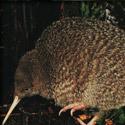
Common name:
Little Spotted Kiwi
Latin name:
Apteryx oweni
Maori name:
Kiwi pukupuku
Sound:
Description:
The smallest of the kiwi family with overall grey colouring and a mottled irregular pattern of black/brown plumage across the body. It weighs between 1.2–2 kgs with a body size around 40 cm. Iris black, feet pale with white claws.
Habitat/Distribution:
Once widespread throughout New Zealand, it is now found only on Kapiti Island and a few other islands, where it has been introduced.
Principal threats:
Conservation status:
The range is restricted
Fact sheet:
Click to download Little Spotted Kiwi fact sheet
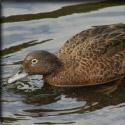
Common name:
Brown Teal (Pateke)
Latin name:
Anas aucklandica chlorotis
Maori name:
Pateke
Sound:
Description:
A small brown duck related to the Chestnut Teal of Australia; around 48 cm in size. Males have dark brown heads with a greenish bloom on nape, a white collar on the front part of neck and a green speculum. The female is uniformly brown with a bluish/black bill and slate grey feet.
Habitat/Distribution:
Restricted mainly to Great Barrier Island and Northland. Captive bred ducks have been released into protected reserves throughout the North Island and into Fiordland National Park.
Principal threats:
Conservation status:
DoC Status: Category B
IUCN Status: Endangered
Fact sheet:
Click to download Brown Teal fact sheet
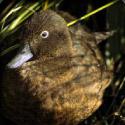
Common name:
Campbell Island Flightless Teal
Latin name:
Anas aucklandica nesiotis
Maori name:
–
Description:
Resembles Auckland Island Teal in both sexes, but slightly smaller and browner. Males do not have a white collar or dark line on the back. The size is around 41 cm.
Habitat/Distribution:
Restricted to the sub-Antarctic Campbell Islands, with a few ducks still residing on Codfish Island from a captive release.
Principal threats:
Conservation status:
Critically endangered
Fact sheet:
Click to download Campbell Island Teal fact sheet
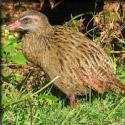
Common name:
North Island Weka
Latin name:
Gallirallus australis greyi
Maori name:
–
Sound:
Description:
A large flightless rail with a strong mandible and feet and reduced wings. The plumage is mainly brown and black, but the tone of the brown and the amount of black vary with more grey on the breast. Legs are brown. Males are 1–1.2 kgs, females between 700–900 grams in weight.
Habitat/Distribution:
Various habitats on offshore islands, Bay of Islands and inland Bay of Plenty.
Principal threats:
-
Introduced predators
-
Introduced bird species
-
Habitat loss, modification and degradation
-
Introduced avian diseases and parasites
-
Vehicles causing road kills
-
Poorly managed pest control operations, traps, rat baits and toxins.
Conservation status:
Threatened, more endangered than the North Island Kiwi
Fact sheet:
Click to download North Island Weka fact sheet
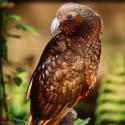
Common name:
North Island Kaka
Latin name:
Nestor meridionalis septentrionalis
Maori name:
Kaka
Sound:
Description:
The sexes are alike, size 45 cm with males 475 grams, females 425 grams. Overall body colouration is brown-green with underling coverts a brilliant orange-scarlet. Crown pale white, iris dark brown, mandible black with yellow cere, feet slate black.
Habitat/Distribution:
Widespread in mature forest throughout New Zealand.
Principal threats:
-
Habitat loss
-
Possums, deer and pigs have reduced their food source
-
Introduced wasps
-
Stoats, rats and possums.
Conservation status:
Threatened endemic species
Fact sheet:
Click to download North Island Kaka fact sheet (PDF)
Common name:
New Zealand Kingfisher
Latin name:
Halcyon sancta
Maori name:
Kotare
Sound:
Description:
The crown and forehead is a deep green with a broad black band running from the gape through and below the eye to encircle the nape. There is a broad buff collar across the hind neck; the upper back and scapulars are deep green, the lower back, upper tail coverts and wings ultramarine, the throat and breast buff/white. The mandible is black with the base of the mandible pale yellowish. Iris black and feet dark brown.
Habitat/Distribution:
Found throughout New Zealand from coastal regions to forested areas. Absent from high, snow-covered mountain areas.
Principal threats:
Introduced mammalian predators.
Conservation status:
Not threatened
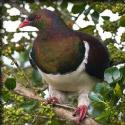
Common name:
New Zealand Pigeon
Latin name:
Hemiphaga novaeseelandiae
Maori name:
Kereru, Kuku, Kukupa
Sound:
Description:
A large pigeon 51 cm in size. The sexes are alike. The head, throat and upper breast are metallic green. The nape, back and wings are purple with a coppery green sheen. Breast and belly and feathered legs are white. The iris is dark red, the mandible crimson with a yellow tip. The feet are red with black claws. The Chatham Island Pigeon is larger than the mainland species, has greyer upper parts and breast and a heavier mandible.
Habitat/Distribution:
Found throughout mainland New Zealand in forested areas and residual forest remnants including some offshore islands. The Chatham Island Pigeon survives on Pitt Island and the main islands, where it inhabits lowland coastal forests.
Principal threats:
Conservation status:
Gradual decline
Fact sheet:
Click to download NZ Pigeon fact sheet
.jpg)
Common name:
Yellow-Crowned Kakariki
Latin name:
Cyanoramphus auriceps
Maori name:
Kakariki
Sound:
Description:
Very similar to the red-crowned parakeet except for the yellow cap. The only other difference is that the red band in front of and behind the eye in the red-crowned parakeet does not extend behind the eye in the yellow-crowned parakeet.
Habitat/Distribution:
Inhabits the North & South Islands and is slowly making a comeback on Stewart Island. Almost exclusively a high forest dweller, especially in old-growth beech and podocarp forests.
Principal threats:
Conservation status:
Uncommon, threatened (regionally)
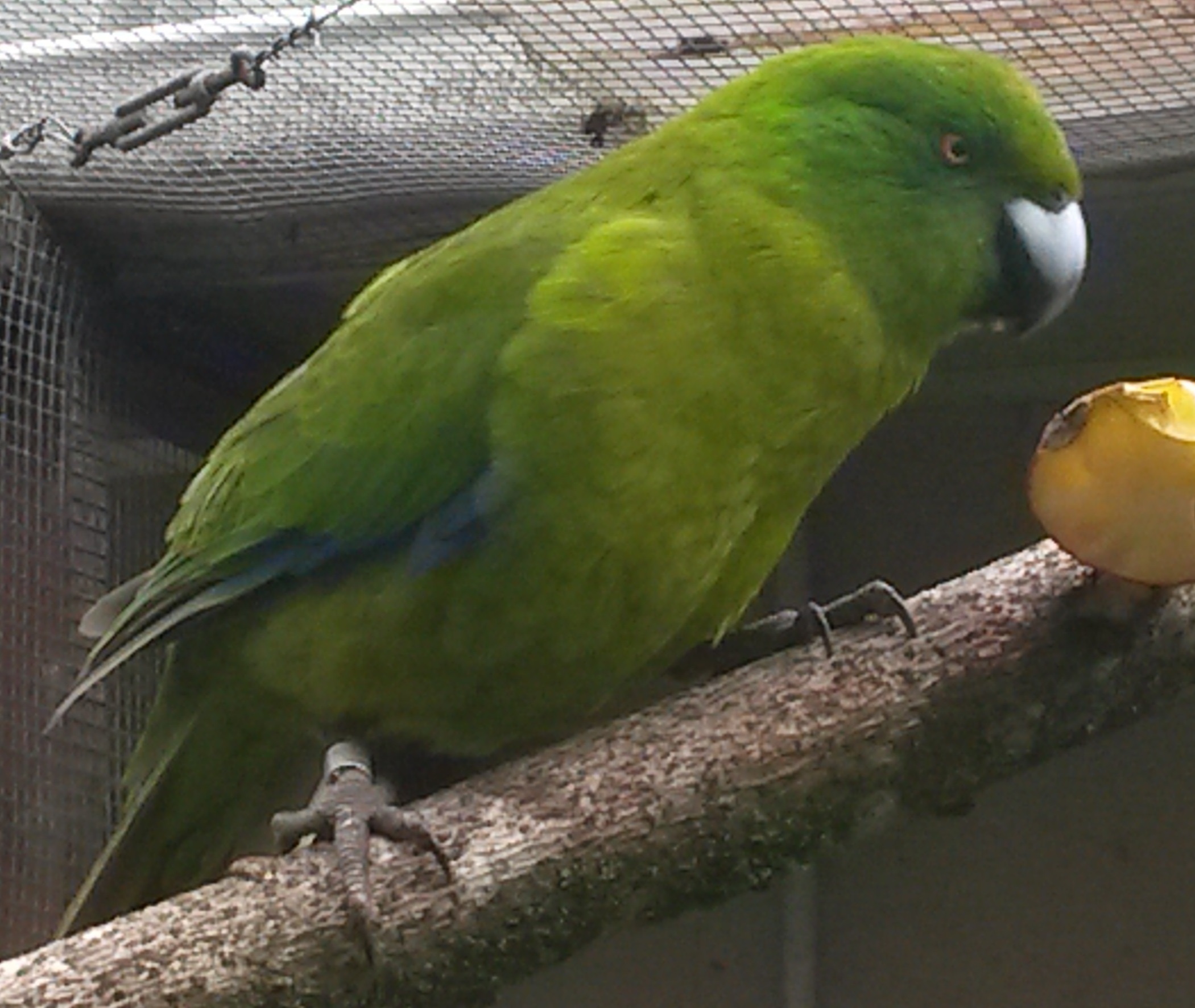
Common name:
Antipodes Island parakeet
Latin name:
Cyanoramphus unicolor
Maori name:
-
Description:
The only all-green parakeet. Although they can fly well, they rarely do so.
Habitat/Distribution:
Found only in the Antipodes Islands, approximately 870 kilometres south east of Bluff, New Zealand. They forage mainly on the ground, feeding on tussock grasses and sedges, and nest in ground burrows, up to 1 metre in length.
Principal threats:
Accidental arrival of mammalian predators such as rats, cats and mustelids, is a potential threat
Conservation status:
Stable & relatively secure in its habitat
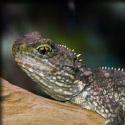
Common name:
Tuatara
Latin name:
Sphenodon punctatus
Maori name:
Tuatara (means 'peaks on the back')
Description:
Similar in appearance to lizards, the tuatara is the only surviving member of a reptile family known as Sphenodon, meaning 'wedge tooth'.
Sphenodons became extinct some 60 million years ago, leaving the tuatara as the last remaining representative or 'living fossil'. Tuatara may live up to 100 years; males weigh around 1 kg and are some 50 cm in length. Females are shorter and a good deal lighter. Skin colouration can vary between animals from an olive green to dark pink or slate grey. Young Tuatara possess a third eye or 'pineal eye', which has a lens, retina and nervous connections to the brain, but has no visual function. Males have no sexual organ. They can swim well and are most active between 7–22 degrees Celsius.
Habitat/Distribution:
Once found right throughout New Zealand, they are now restricted to predator-free offshore islands.
Principal threats:
Conservation status:
Protected since 1895
Fact sheet:
Click to download Tuatara fact sheet